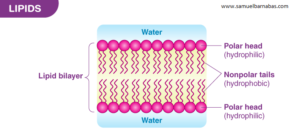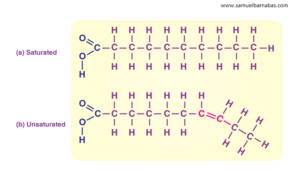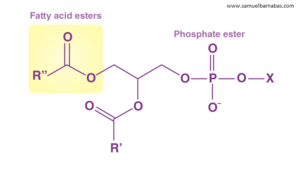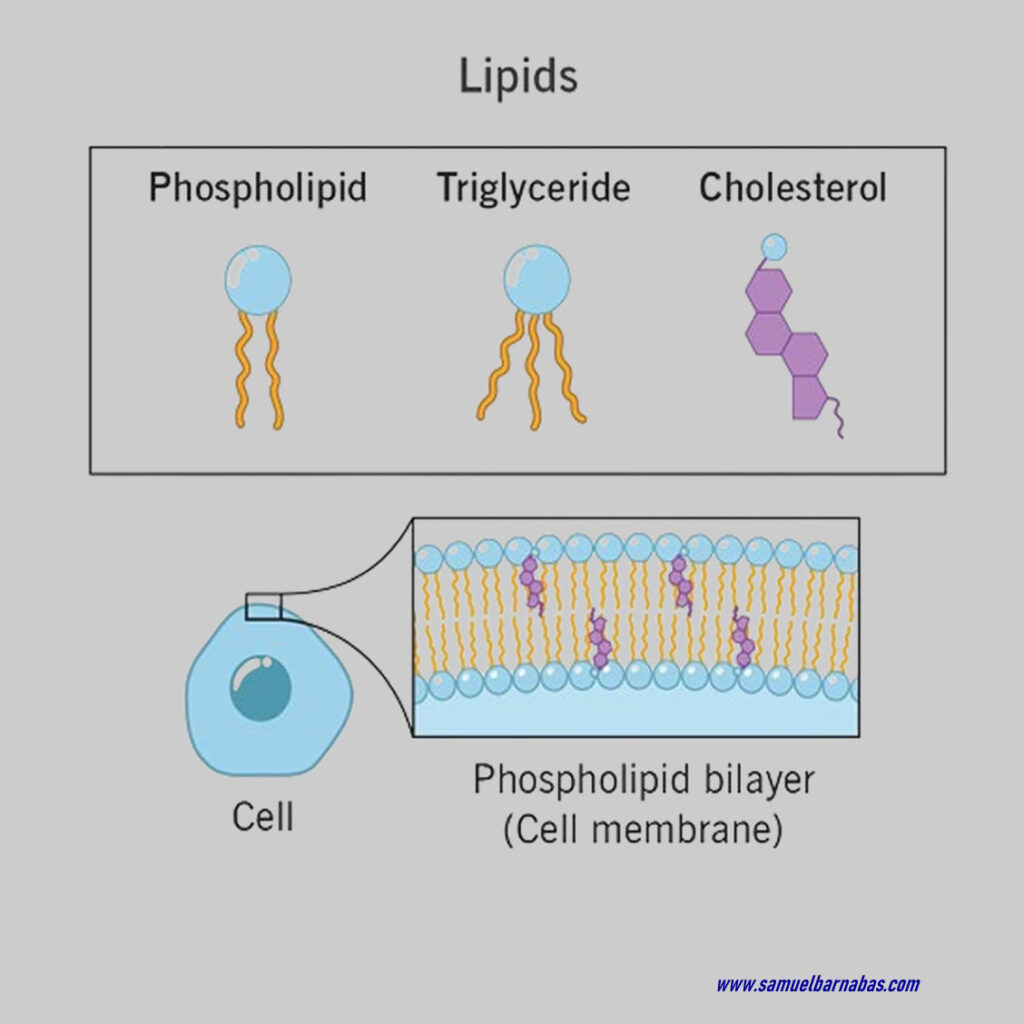Lipids
Lipids Definition
“Lipids are organic compounds that contain hydrogen, carbon, and oxygen atoms, which form the framework for the structure and function of living cells.”
What are Lipids?
These specific organic compounds are characterized as nonpolar molecules, displaying solubility solely in nonpolar solvents while remaining insoluble in water due to water’s polar nature. Within the human body, they are often synthesized within the liver and are notably present in oil, butter, whole milk, cheese, fried foods, and select red meats.
Let’s delve into the detailed exploration of lipid structure, properties, types, and lipid classification.
Also read: Biomolecules

Properties of Lipids
Lipids, encompassing fats and oils, are a vital group of organic compounds within the human body, offering substantial energy and fulfilling diverse functions. Here are some key characteristics of lipids:
- Lipids are characterized as oily or greasy nonpolar molecules, primarily stored in the body’s adipose tissue.
2. Comprising a heterogeneous array of compounds, lipids are predominantly composed of hydrocarbon chains.
3. These organic molecules are rich in energy, serving as a vital source for various life processes.
4. Lipids are distinguished by their solubility in nonpolar solvents and lack of solubility in water.
5. Within biological systems, lipids play a pivotal role in forming a protective barrier known as the cell membrane, which separates cells from their external environment.
Also Read: Digestion and Absorption of Lipids
Lipid Structure
Lipids consist of polymers of fatty acids, comprising a lengthy non-polar hydrocarbon chain with a small polar region containing oxygen, as depicted in the diagram below:

Lipid Structure – Saturated and Unsaturated Fatty Acids
Classification of Lipids
Lipids can be categorized into two primary classes:
- Nonsaponifiable lipids
- Saponifiable lipids
Nonsaponifiable Lipids
A nonsaponifiable lipid is unable to be broken down into smaller molecules through hydrolysis. Examples of nonsaponifiable lipids include cholesterol, prostaglandins, etc.
Saponifiable Lipids
A saponifiable lipid contains one or more ester groups, allowing it to undergo hydrolysis in the presence of a base, acid, or enzymes. Examples of saponifiable lipids include waxes, triglycerides, sphingolipids, and phospholipids.
These categories can further be divided into nonpolar and polar lipids.
Nonpolar lipids, such as triglycerides, are utilized as fuel and for energy storage.
Polar lipids, which can form a barrier with an external water environment, are used in membranes. Examples of polar lipids include sphingolipids and glycerophospholipids.
Fatty acids are crucial components of all these types of lipids.
Types of Lipids
Within these two major classes of lipids, there are numerous specific types that are important for life. These include:
- Fatty acids
- Triglycerides
- Glycerophospholipids
- Sphingolipids
- Steroids
These lipids are broadly classified as simple lipids and complex lipids.
Also read: Biomolecules in Living Organisms
Simple Lipids
These are some examples of esters of fatty acids with various alcohols:
1. Fats: These are esters of fatty acids with glycerol. When in a liquid state, they are referred to as oils.
2. Waxes: These are esters of fatty acids with higher molecular weight monohydric alcohols.
Complex Lipids
These are some examples of esters of fatty acids containing groups in addition to alcohol and fatty acid:
- Phospholipids: These are lipids that contain, along with fatty acids and alcohol, a phosphate group. They often include nitrogen-containing bases and other substituents. For example, glycerophospholipids have glycerol as the alcohol component, while sphingophospholipids have sphingosine.
- Glycolipids (or glycosphingolipids): These are lipids that contain a fatty acid, sphingosine, and a carbohydrate.
- Other complex lipids: This category includes lipids such as sulfolipids and amino lipids. Lipoproteins can also be classified under this category.
- Precursor and Derived Lipids: These include fatty acids, glycerol, steroids, other alcohols, fatty aldehydes, and ketone bodies, hydrocarbons, lipid-soluble vitamins, and hormones. Because they are uncharged, acylglycerols (glycerides), cholesterol, and cholesteryl esters are termed neutral lipids. These compounds are produced by the hydrolysis of simple and complex lipids.
Some of the different types of lipids are described below in detail.
Fatty Acids
Fatty acids are organic acids, typically characterized by long aliphatic tails, which can be either unsaturated or saturated.
1. Saturated fatty acids:
– These fatty acids lack carbon-carbon double bonds, indicating a saturated structure. Due to this, saturated fatty acids tend to have higher melting points compared to unsaturated fatty acids of similar size. This is because they are able to pack their molecules closely together, resulting in a straight, rod-like shape.
2. Unsaturated fatty acids:
– Unsaturated fatty acids have one or more double bonds in their carbon chain.
– Naturally occurring fatty acids often possess an even number of carbon atoms and have unbranched structures.
– The presence of cis-double bonds in unsaturated fatty acids creates a structural kink, preventing them from forming a straight, rod-like shape as observed in saturated fatty acids.
Role of Fats
Fats serve several crucial roles within the body. Here are some of the key functions of fats:
1. Essential for Proper Body Functioning:
– Fats, when consumed in appropriate amounts, are vital for the normal functioning of our body.
2. Facilitate Absorption of Fat-Soluble Vitamins:
– Many fat-soluble vitamins, such as Vitamins A, D, E, and K, require fats for efficient absorption in the body.
3. Provide Insulation:
– Fats act as a form of insulation for the body, helping to maintain body temperature.
4. Efficient Energy Storage:
– Fats are a highly efficient way for the body to store energy over longer periods of time, providing a reserve of energy when needed.
Also Read: Fats
Examples of Lipids
There are various types of lipids, with examples including butter, ghee, vegetable oil, cheese, cholesterol, steroids, waxes, phospholipids, and fat-soluble vitamins. These compounds share common characteristics such as being insoluble in water and soluble in organic solvents.
Waxes
Waxes are esters, which are organic compounds formed by replacing the hydrogen of an acid with an alkyl or another organic group. They are typically derived from long-chain alcohols and long-chain carboxylic acids.
Waxes are widely distributed in nature. Many plants have waxy coatings on their fruits and leaves, which serve to protect them from small predators and dehydration.
The fur of some animals and the feathers of birds also have these coatings, acting as water repellents.
Carnauba wax, for instance, is well-known for its water resistance and toughness, making it a valuable ingredient in products like car wax.
Phospholipids

Membranes and Phospholipids
Membranes are primarily composed of phospholipids known as Phosphoacylglycerols.
Triacylglycerols and phosphoacylglycerols share similarities, but the key difference lies in the terminal OH group of the phosphoacylglycerol being esterified with phosphoric acid instead of a fatty acid. This modification results in the formation of phosphatidic acid.
The term “phospholipid” stems from the fact that phosphoacylglycerols are lipids containing a phosphate group.
Steroids
In our bodies, hormones act as chemical messengers, organic compounds synthesized in glands and transported through the bloodstream to various tissues to either initiate or inhibit specific processes.
Steroids are a type of hormone characterized by their tetracyclic skeleton, composed of three fused six-membered and one five-membered ring, as depicted above. The rings are denoted as A, B, C, and D, indicated in blue shading, with the red numbers marking the carbons.
Cholesterol
Cholesterol is a wax-like substance exclusively found in animal-derived foods. Triglycerides, LDL, HDL, VLDL are various types of cholesterol present in blood cells.
Cholesterol serves as a vital lipid in the cell membrane, categorized as a sterol—a combination of a steroid and alcohol. In the body, cholesterol is synthesized primarily in the liver.
These compounds are biosynthesized by all living cells and are essential for the structural integrity of cell membranes. Within the cell membrane, the steroid ring structure of cholesterol provides a rigid hydrophobic framework, enhancing the membrane’s stability. Without cholesterol, the cell membrane would exhibit excessive fluidity.
Cholesterol not only acts as a key component of cell membranes but also serves as a precursor for the synthesis of other steroids. This includes sex hormones like estradiol and testosterone, as well as other essential steroids such as cortisone and vitamin D.
Also Refer: Vitamins and Minerals
Frequently Asked Questions
What are lipids?
Lipids are organic compounds that are fatty acids or derivatives of fatty acids, which are insoluble in water but soluble in organic solvents. For eg., natural oil, steroid, waxes.
How are lipids important to our body?
Lipids play a very important role in our body. They are the structural component of the cell membrane. They help in providing energy and produce hormones in our body. They help in the proper digestion and absorption of food. They are a healthy part of our diet if taken in proper amounts. They also play an important role in signalling.
How are lipids digested?
The enzyme lipase breaks down fats into fatty acids and glycerol, which is facilitated by bile in the liver.
What is lipid emulsion?
It refers to an emulsion of lipid for human intravenous use. These are also referred to as intralipids which is the emulsion of soybean oil, glycerin and egg phospholipids. It is available in 10%, 20% and 30% concentrations.
How are lipids metabolized?
Lipid metabolism involves the oxidation of fatty acids to generate energy to synthesize new lipids from smaller molecules. The metabolism of lipids is associated with carbohydrate metabolism as the products of glucose are converted into lipids.
How are lipids released in the blood?
The medium-chain triglycerides with 8-12 carbons are digested and absorbed in the small intestine. Since lipids are insoluble in water, they are carried to the bloodstream by lipoproteins which are water-soluble and can carry the lipids internally.
What are the main types of lipids?
There are two major types of lipids- simple lipids and complex lipids. Simple lipids are esters of fatty acids with various alcohols. For eg., fats and waxes. On the contrary, complex lipids are esters of fatty acids with groups other than alcohol and fatty acids. For eg., phospholipids and sphingolipids.
What are lipids made up of?
Lipids are made up of a glycerol molecule attached to three fatty acid molecules. Such a lipid is called triglyceride.

